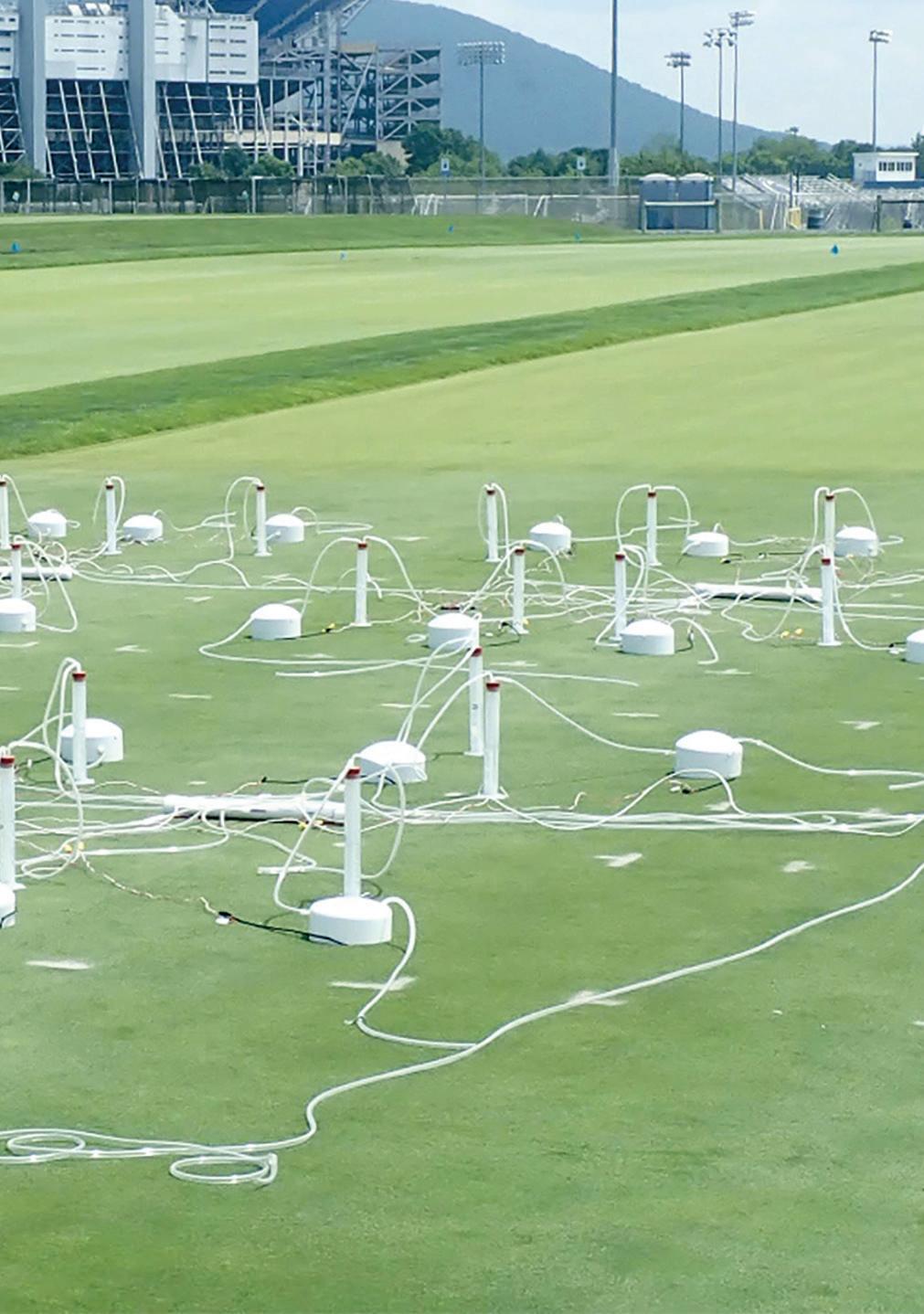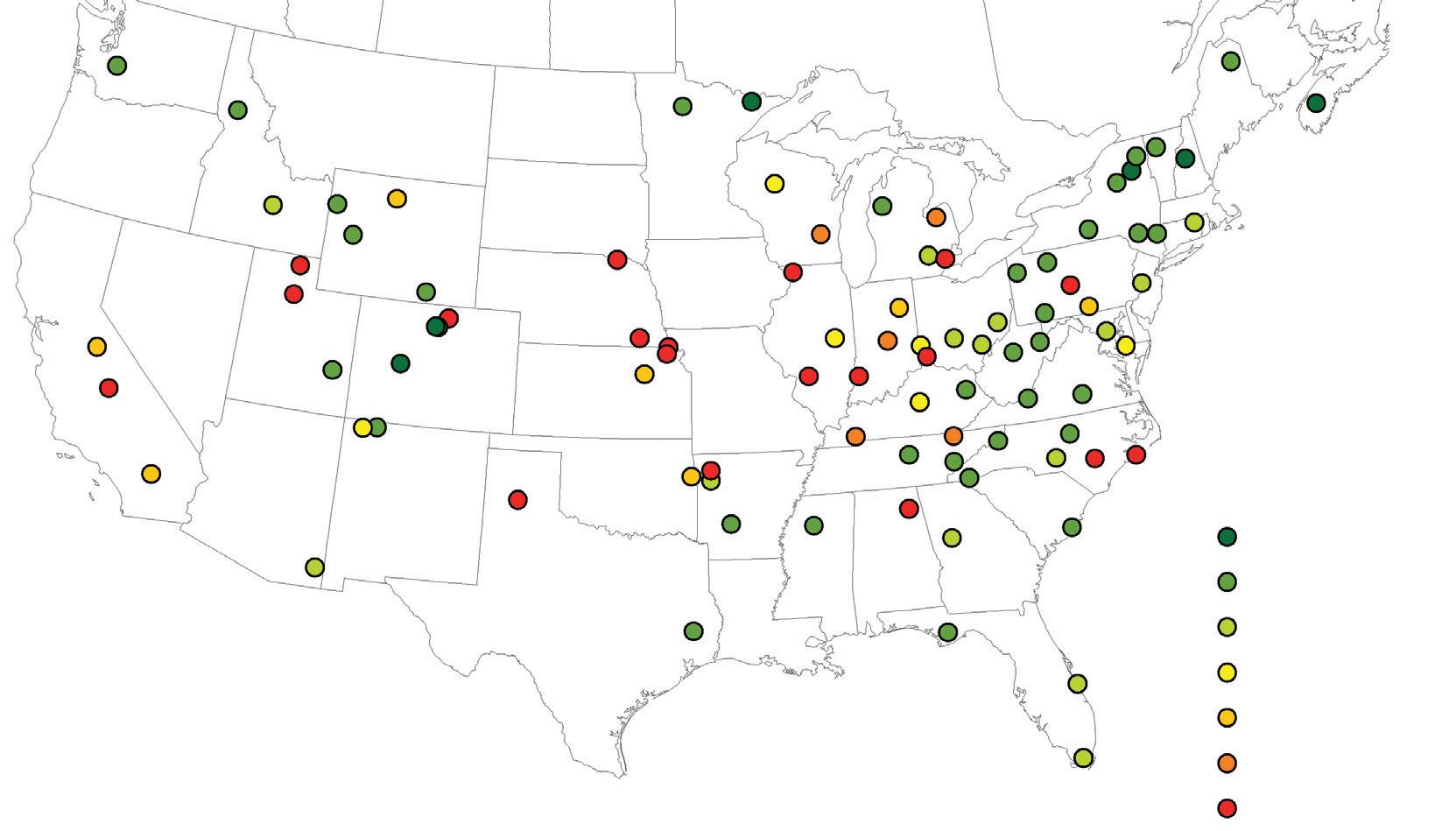
7 minute read
How Does Fertilizer N Evade Turfgrass Assimilation as Gas?
By Max Schlossberg, Ph.D., and Nate Leiby, MS Graduate Student (BS TURF ’18), Center for Turfgrass Science, The Pennsylvania State University.
Well, to the satisfaction of article browsers, more easily and often than most realize. But the best answer remains; ‘it depends.’ Turfgrass requires greater quantities of N than any other mineral nutrient, and N sufficiency is promptly supported, or N deficiency is promptly reversed, by application of soluble N fertilizer(s) containing urea, NH 4 , and/or NO 3 . There are four N-rich gases that arise from N fertilizers; dinitrogen (N 2 ), nitrous oxide (N 2 O), nitric oxide (NO), and ammonia (NH 3 ). In fact, every plant-available N-form (urea, NO 3 , NH 4 ), or intermediate (NO 2 ), serves as soil feedstock for at least one of the above gases. Evolution of these gases from originally plant available N-forms is undesirable. But once emitted, N 2 is the least problematic of the bunch.
Advertisement
N2 O Emissions
Agricultural soil is the greatest source of anthropogenic N 2 O emission on earth, accounting for nearly 70% of annual totals. Industry and combustion (fossil/other fuels) are the next greatest contributors. Nitrous oxide is a tenacious greenhouse gas that reduces protective ozone and claims very few opportunities for transformation or sequestration.
Incomplete soil denitrification of nitrate
Denitrification is the microbiologically mediated reduction of NO 2 and/or NO 3 following incorporation of soluble N fertilizer into warm, saturated soil. Under such conditions, the nitrate fraction of a soluble fertilizer application relates directly to early denitrification severity (Figure 1). Turfgrass systems maintained on highly porous rootzones underlain by functional drainage are unlikely to lose N via denitrification. While systems maintained on native soils having high organic matter content and/or water-retention are more likely, especially in mid- to late-summer.

Figure 1
This is the part of the article where we considered introducing complete vs. incomplete denitrification, and describing the more benign product (N 2 ) of the former and all the a/biotic factors identified by research as comparative facilitators of it. But in the context of modern cultural techniques developed and/or adopted by the most effective turfgrass managers worldwide, it’s a non-starter. No turfgrass manager should maximize water-filled pore space in efforts toward favoring the N 2 denitrification product.
Incomplete soil nitrification of ammonium
Nitrification is the microbiologically mediated oxidation of soil ammonium (NH 4 ) and a notoriously prolific generator of soil acidity. Nitrification is a two-stage process, each depending on a separate genus of chemolithoautrophic microbes. Regrettably the second stage, oxidation of NO 2 to NO 3 , is often limited by success of the first; oxidation of NH 4 to NO 2 . Which constitutes feedback inhibition, but by no means incites greater risk to the product of the first stage, right? Wrong. Local oxygen depletion incites electron acceptance by the freshly oxidized NO 2 , catastrophically reducing it to NO or N 2 O. Most readers will recognize ‘… fate, it seems, is not without a sense of irony…’ as a quote by Morpheus in The Matrix (1999). But how many know Morpheus was referring to nitrogen? Hmmmm, Danny?
NH 3 Emissions
Most atmospheric ammonia in North America originates from livestock operations and fertilizer application. In the presence of nitrate or sulfate, NH 3 constitutes the most significant and influential precursor to smog formation, i.e., particulate matter <2.5 micrometers in diameter (PM 2.5 ). Elevated PM 2.5 levels are monitored in numerous nonattainment regions along the US Eastern Seaboard and are statistically correlated to adverse health effects. Furthermore, ammonia deposition to surfaces, the primary atmospheric removal mechanism, is considered a significant threat to terrestrial and aquatic ecosystem health.
Urea hydrolysis
Of the soluble N fertilizers, urea (46-0-0) is the safest (lowest risk of desiccating tissue) and most cost effective on a unit N basis. Current urea fertilizer best management practices (BMPs) encourage prompt ‘soil incorporation’ by cultivation, coinciding rainfall, or scheduled irrigation event(s). Yet, turfgrass managers’ short-term prioritization of nutrient sufficiency and clientele satisfaction can preclude rainfall/ irrigation concomitance. A sizable body of published results, old and new, confirm the cost of such inaction. Most recently, following granular urea-N application to a K. bluegrass lawn at 0.9 lbs N/1000 sq. ft., Penn State Univ. researchers determined 23% of the applied urea-N volatilized over just 3 days of dry conditions. Regarding foliar application of urea-N at 0.15 to 0.41 lbs N/1000 sq. ft. to putting greens, Penn State Univ. researchers directly measured gaseous NH 3 loss of 5 to 11% of the applied fertilizer over 24 hours of dry conditions (Figure 2).

Figure 2
Disassociation of ammonium
Ammonium (NH 4 ) fertilizer, as well as NH 4 either hydrolyzed from urea fertilizer or mineralized from organic matter, comprise a plant available N form. However, soil NH 4 is subject to gaseous loss. Conditions favoring this fate include: limited oxygen that incites incomplete denitrification to NO/N 2 O emission (as described) and moderate to severe alkalinity causing NH 4 to donate its proton and volatilize as NH 3 .
Soluble NH 4 -sulfate fertilizer (21-0-0) is the N source of choice to supply both plant-available N and pH-lowering acid. However, turfgrass soils/rootzones with pH levels >7.9 are actually too alkaline to support both objectives. Spoiler alert: plant-available N delivery will fall short of the application rate! Severely alkaline soil is better acidified and N fertilized by application of NH 4 -thiosulfate (12-0-0), or combinations of 21-0-0 and flowable elemental sulfur or K-thiosulfate (0-0-25), all complimented by nitrification inhibitor(s).
Preventing gaseous loss of fertilizer N
Employ physical cultivation to maximize air-filled pore space in the upper rootzone and adopt a frugal and unenthusiastic irrigation ideology. These efforts will support gas exchange and an aerobic rhizosphere more effectively than the alternative. Avoid NO 3 -N sources when fertilizing: area under establishment, poorly drained areas, at the onset of a wet season or prolonged/intense precipitation event, and in the warmest months of the growing season.
Avoid conventional urea-N sources when: rainfall/ irrigation is unavailable, temperatures are in excess of 85 F, treatment areas are moderately- to severely alkaline; excessively thatchy, and/or within a PM 2.5 non-attainment region (Figure 3). Instead, apply N-fertilizers that feature efficiency enhancements (Figure 1), in accordance with regulations, and as needed to support desired density and vigor. Field research described above shows supplanting 25% of conventional urea-N with polymer-/sulfur- coated urea prevented 6.5% of the fertilizer-N from volatilizing 0- to 3-days following broadcast application.

Figure 3 2017 Average Ambient Ammonia Concentration http://nadp.slh.wisc.edu/lib/brochures/AMoNSheet.pdf
When rainfall/irrigation is unavailable, yet fully-soluble N is needed by a system growing on acidic to neutral soil, apply NH 4 -, urea-, and/or urea-formaldehyde reaction product-based N-sources, complimented by 0.1% N-butylthiophosphoric triamide (NBPT) and 2.0% dicyandiamide (DCD) urease and nitrification inhibitors respectively. Above described research showed over the 3 days following application of 0.9 lbs N/1000 sq. ft. of K. bluegrass, granular enhanced efficiency urea (stabilized with NBPT and DCD) emitted less than half the NH 3 as conventional urea. Re-apply in accordance with regulations and only as needed to support desired density and vigor.
Future Direction and Summary
Ongoing field research comprising the co-author’s graduate thesis is evaluating NH 3 volatilization and associated factors following urea and urea-based fertilizer application to creeping bentgrass fairways and putting greens. The more interesting of the experimental treatments is the complimenting of foliar urea-N applications by a petroleum derived spray oil. More results are pending!
To date, our research fully supports the 2014 designation of NBPT-amendment of urea as a Category 1 strategy/ technique for abatement of NH 3 emissions by the UNECE Task Force on Reactive Nitrogen. Category 1 techniques are deemed practical, verifiably-efficient, and recommended for use in abatement strategies; relative to a broadcast application of conventional urea fertilizer. If no other soluble N-fertilizer source is available to support a critically-important granular application under warm, dry conditions, then employ of a NBPT+DCD-amended urea fertilizer constitutes a recommended best management practice (BMP).
References
Bittman, S., M. Dedina, C.M. Howard, O. Oenema, and M.A. Sutton. 2014. Options for Ammonia Mitigation: Guidance from the UNECE Task Force on Reactive Nitrogen, Centre for Ecology and Hydrology, Edinburgh, UK. Available at: www.clrtap-tfm.org
Holst, G.J., M. Thygesen, C.B. Pedersen, R.G. Peel, J. Barndt, J.H. Christiensen, J. Bonlokke, O. Hertel, and T. Sigsgaard. 2017. Atmospheric ammonia, ammonium and incident asthma- A nationwide case-control study in Danish preschool children. European Respiratory J. 50:OA502, DOI: 10.1183/ 1393003.congress-2017.OA502
Schlossberg, M.J., B.A. McGraw, and R.L. Sebring. 2018. Ammonia volatilization from putting greens foliarly-fertilized by conventional or stabilized urea. Agric. Environ. Lett. 3:180019. doi:10.2134/ael2018.04.0019
Schlossberg, M.J., B.A. McGraw, R.L. Sebring, and K.R. Hivner. 2018. Nitrogen recovery and loss from Kentucky bluegrass fertilized by conventional or enhanced-efficiency urea granules. Agronomy 8:144. doi:10.3390/ agronomy8080144









